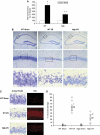Neuroglobin protects neurons against oxidative stress in global ischemia
- PMID: 20571522
- PMCID: PMC3023926
- DOI: 10.1038/jcbfm.2010.90
Neuroglobin protects neurons against oxidative stress in global ischemia
Abstract
Neuroglobin (Ngb) is a recently discovered globin that affords protection against hypoxic/ischemic-induced cell injury in brain. Hypoxic/ischemic injury is associated with accumulation of reactive oxygen species (ROS) and/or reactive nitrogen species (RNS). In previous studies, we found that Ngb has antioxidative properties, and protects PC-12 cells against hypoxia- and β-amyloid-induced cell death. To further delineate the potential role of Ngb in protection against cerebral ischemia-reperfusion injury in vivo, we developed a transgenic mouse line that overexpresses Ngb. Hippocampal ischemia-reperfusion injury was induced by a 10-minute bilateral occlusion of the common carotid arteries, and the animal brains were assessed 3 days later. CA1 neural injury was determined by cresyl violet staining. Lipid peroxidation was assessed using a malonyldialdehyde assay kit, whereas ROS/RNS accumulation was determined by Het staining in the CA1 hippocampal region. Hippocampal Ngb mRNA and protein expressions were assessed by reverse transcriptase-PCR and western blotting, respectively. Neuroglobin was successfully overexpressed in the hippocampus of Ngb transgenic mice. After ischemia-reperfusion, CA1 ROS/RNS production and lipid peroxidation were markedly decreased in Ngb transgenic mice compared with wild-type mice. Furthermore, CA1 neuronal injury was also markedly reduced. Thus, Ngb may confer protection against ischemia-reperfusion injury in the brain through its intrinsic antioxidant properties.
Figures




Similar articles
-
Neuroglobin protects PC12 cells against oxidative stress.Brain Res. 2008 Jan 23;1190:159-66. doi: 10.1016/j.brainres.2007.11.022. Epub 2007 Nov 22. Brain Res. 2008. PMID: 18083144 Free PMC article.
-
The role of neuroglobin in the neuroprotection of limb ischemic preconditioning in rats.Mol Neurobiol. 2013 Feb;47(1):197-208. doi: 10.1007/s12035-012-8373-7. Epub 2012 Nov 21. Mol Neurobiol. 2013. PMID: 23180278
-
Effects of intermittent hypobaric hypoxia preconditioning on the expression of neuroglobin and Bcl-2 in the rat hippocampal CA1 area following ischemia-reperfusion.Genet Mol Res. 2015 Sep 9;14(3):10799-807. doi: 10.4238/2015.September.9.18. Genet Mol Res. 2015. PMID: 26400308
-
Neuroglobin, a novel target for endogenous neuroprotection against stroke and neurodegenerative disorders.Int J Mol Sci. 2012;13(6):6995-7014. doi: 10.3390/ijms13066995. Epub 2012 Jun 7. Int J Mol Sci. 2012. PMID: 22837676 Free PMC article. Review.
-
Neuroglobin: an endogenous neuroprotectant.Curr Opin Pharmacol. 2008 Feb;8(1):20-4. doi: 10.1016/j.coph.2007.09.003. Epub 2007 Oct 17. Curr Opin Pharmacol. 2008. PMID: 17942367 Free PMC article. Review.
Cited by
-
Neuroglobin protects cardiomyocytes against apoptosis and cardiac hypertrophy induced by isoproterenol in rats.Int J Clin Exp Med. 2015 Apr 15;8(4):5351-60. eCollection 2015. Int J Clin Exp Med. 2015. PMID: 26131111 Free PMC article.
-
Neuroglobin mediates neuroprotection of hypoxic postconditioning against transient global cerebral ischemia in rats through preserving the activity of Na+/K+ ATPases.Cell Death Dis. 2018 May 25;9(6):635. doi: 10.1038/s41419-018-0656-0. Cell Death Dis. 2018. PMID: 29802248 Free PMC article.
-
t-BHQ Provides Protection against Lead Neurotoxicity via Nrf2/HO-1 Pathway.Oxid Med Cell Longev. 2016;2016:2075915. doi: 10.1155/2016/2075915. Epub 2015 Dec 21. Oxid Med Cell Longev. 2016. PMID: 26798413 Free PMC article.
-
Huntingtin polyQ Mutation Impairs the 17β-Estradiol/Neuroglobin Pathway Devoted to Neuron Survival.Mol Neurobiol. 2017 Oct;54(8):6634-6646. doi: 10.1007/s12035-016-0337-x. Epub 2016 Dec 12. Mol Neurobiol. 2017. PMID: 27957684
-
Neuroglobin Can Prevent or Reverse Glaucomatous Progression in DBA/2J Mice.Mol Ther Methods Clin Dev. 2017 Apr 27;5:200-220. doi: 10.1016/j.omtm.2017.04.008. eCollection 2017 Jun 16. Mol Ther Methods Clin Dev. 2017. PMID: 28540323 Free PMC article.
References
-
- Baldus S, Eiserich JP, Brennan ML, Jackson RM, Alexander CB, Freeman BA. Spatial mapping of pulmonary and vascular nitrotyrosine reveals the pivotal role of myeloperoxidase as a catalyst for tyrosine nitration in inflammatory diseases. Free Radic Biol Med. 2002;33:1010–1019. - PubMed
-
- Burmester T, Weich B, Reinhardt S, Hankeln T. A vertebrate globin expressed in the brain. Nature. 2000;407:520–523. - PubMed
-
- Chan PH. Reactive oxygen radicals in signaling and damage in the ischemic brain. J Cereb Blood Flow Metab. 2001;21:2–14. - PubMed
-
- Chan PH, Epstein CJ, Kinouchi H, Kamii H, Imaizumi S, Yang G, Chen SF, Gafni J, Carlson E. SOD-1 transgenic mice as a model for studies of neuroprotection in stroke and brain trauma. Ann NY Acad Sci. 1994;738:93–103. - PubMed
-
- Clemens JA. Cerebral ischemia: gene activation, neuronal injury, and the protective role of antioxidants. Free Radic Biol Med. 2000;28:1526–1531. - PubMed
Publication types
MeSH terms
Substances
Grants and funding
LinkOut - more resources
Full Text Sources
Other Literature Sources
Miscellaneous

